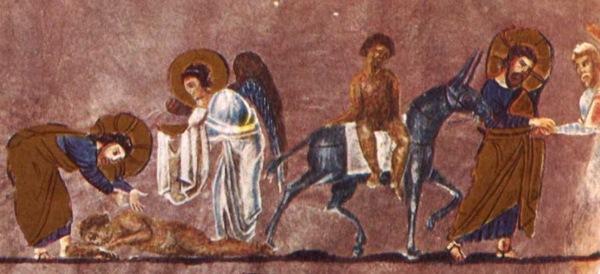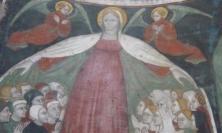‘This Jubilee Year of Mercy excludes no one.’ So wrote Pope Francis in a letter in which he stated his intention to allow all priests to grant absolution for abortion, and to validate absolutions granted by priests of the Society of St Pius X, during the Jubilee Year. Both such decisions registered as ‘scandalous’ in some quarters – but mercy is scandalous, says James Keenan SJ, precisely because it excludes no one. How and why has the Church practised this mercy through the centuries by responding to those most in need?
I believe that mercy defines Catholicism. And I define mercy as the willingness to enter into the chaos of another. In this article I want to highlight how scandalous mercy is, in the multitude of ways that specific works of mercy might be scandalous, but first I want to ask two questions: why is mercy so significant and when did mercy become so important?
Why mercy?
We could give many reasons why mercy is important for Catholics, but the basic reason is: Jesus commanded it. Two texts are particularly important: the Good Samaritan from Luke’s Gospel and the Last Judgment from Matthew’s Gospel.
The Parable of the Good Samaritan (Luke 10:29-37) portrays mercy as the definitive expression of the ‘love of neighbour’ command. It is important for us to remember why Jesus tells this parable. He has just given the commandment to love one another and in response, one of the Scribes asked Jesus, ‘Who is my neighbour?’ Jesus responds by telling the Parable of the Good Samaritan; a close reading of the story reveals that Jesus is offering a very surprising answer to the question.
At the beginning of the story we are thinking that the answer to the question, ‘who is my neighbour?’ is: ‘the man lying wounded on the road’. But by the end of the story we are no longer looking at the neighbour who is wounded but rather at the neighbour who is acting. The Scribe therefore answers that the neighbour is the one who shows mercy. In the beginning, we think the parable is about whom we should assist. But the end is really about who we are called to be. We are called to be like the Good Samaritan, that is, to be a neighbour.
Many of us forget that this parable was never primarily a moral one. Throughout the tradition, many preachers and theologians saw in the story of the Good Samaritan the narrative (in miniature) of our redemption by Christ. Starting with Clement of Alexandria (c.150-c.215), then Origen (c.184-c.254), Ambrose (339-390) and finally, Augustine (354-430), the Good Samaritan parable has been interpreted as the merciful narrative of our redemption. Later, from Venerable Bede (673–735) to Martin Luther (1483-1546), preachers and theologians appropriate and modify the narrative, but in each instance, the narrative is first and foremost not about us, but rather about Jesus Christ!
The basic allegorical expression of the parable was this: the man who lies on the road is Adam, wounded (by sin), suffering outside the gates of Eden. The priest and the Levite (the law and the prophets) are unable to do anything for Adam. Along comes the Good Samaritan (Christ), a foreigner, one not from here, who tends to Adam’s wounds, takes him to the inn (the Church), gives a down payment of two denarii, (the two commandments of love), leaves him in the inn (the Church) and promises to return for him (the second coming, when he will pay in full for the redemption and take him with him into his kingdom).
The parable is first and foremost not a story about how we should treat others, but rather the story of what Christ has done for us. We are called to follow the actions of the Good Samaritan not because the parable is an attractive one, but because it is a retelling of the entire Gospel. The parable is not, then, one among many: besides serving as the foundational explanation of the love command, it is also the allegorical account of salvation history. The parable is about the scandal of our redemption.
This leads to the second point, namely, that the Scriptures, and in particular Matthew’s Gospel, name mercy as the condition for salvation. This is made clear in the Last Judgment in Matthew 25, where the saved are those who performed what we later called the corporal works of mercy.
The parable of Matthew 25 is striking in that everyone is surprised by the judgment. The sheep never realised that in feeding the hungry, they were feeding the king; unfortunately, the goats never realised that by not visiting the sick, they were not visiting the Lord. For Matthew we will be judged by whether we practised mercy and we will not be excused if we did not know to practise it. Thus, like Matthew's goats, the rich man in Luke 6 learns this ‘moral’ in Hades; he never showed mercy to poor Lazarus begging at his gate. The practice of mercy is the measure of our judgment. It should be as scandalous as the scandal of our own salvation.
When did mercy become so important?
Much could be written about how the corporal works of mercy developed as such. We know them to be seven: feed the hungry; give drink to the thirsty; shelter the homeless; clothe the naked; visit the sick; visit the imprisoned; and bury the dead. These are later paired with the spiritual works: give good counsel; teach the ignorant; admonish sinners; console the afflicted; pardon offences and injuries; bear offences patiently; and pray for the living and the dead.
While the first six of the corporal works of mercy are found in Matthew 25, it took several centuries for the final articulation of these ‘seven’ to become a cornerstone of the Christian life. Eventually they parallel other groups of seven, such as the seven sacraments, the seven deadly sins and the virtues (four cardinal; three theological).
Before the set mantra of seven was firmly situated, Christians heard the divine injunction to practise mercy. John never tires of recommending it (1 John 4:20-21, for example). Luke tells us how deacons are appointed to serve the most marginalised (Acts 6:1-6). Paul writes to Timothy about the selection of widows who, like the deacons, are to serve those in need (1 Timothy 5:9-10). Collectively and institutionally, the apostolic Church promotes the service of mercy.
Almsgiving becomes an early expression of mercy. Clement writes: ‘Almsgiving is good as a penance for sin; fasting is better than prayer, but almsgiving is better than both, and charity covers a multitude of sins’ (2 Clement 16). In the apostolic age, the practise of mercy is expressed in taking up a collection on the first day of every week (presumably during the Eucharist), as Paul instructs the Corinthians (1 Corinthians 16:1-2).
These many calls to mercy are heeded. For instance, Cyprian, bishop of Carthage, leads his congregation to respond to victims of the plague in 252. Bishop Dionysius provides a narrative of his community’s response to the plague in Alexandria in 259:
Most of our brethren, in their surpassing charity and brotherly love did not spare themselves and clinging to one another fearlessly visited the sick and ministered to them. Many, after having nursed and consoled the sick, contracted the illness and cheerfully departed this life. The best of our brethren died in this way, some priests and deacons, and some of the laity. (Eusebius, Hist. Eccl. 7.22.9)
Always mindful of their need to be forgiven, Christians practised mercy with abandon, without ever excluding anyone.
The scandal of mercy
In the Middle Ages, the monasteries become centres for extraordinary mercy. One account from the famed monastery at Cluny, for instance, informs us that 17,000 persons were cared for in one year. Among the Cistercians, every abbey had a guest house for pilgrims, travellers and the poor, where the abbot waited on them after first welcoming them by prostrating himself at their feet.
Besides the monks, pious laypersons participated in the works of mercy by forming ‘lay associations.’ These began in Naples in the 10th century and later appeared in Tuscany. By the 12th century they were found throughout France, Spain and Italy, assisting members of religious orders in their apostolates mostly by establishing and maintaining hospitals. For instance, in 1217, a hospital that once belonged to a religious community was handed over to a corporation of four priests, thirty laymen and twenty-five laywomen. By the 13th and 14th century, these activities were flourishing throughout Europe.
With the spirit of Francis and Dominic in the 13th century, many professional laypersons became inspired and answered the call to mercy with great imagination. For instance, in 1244, the head porter of a wool guild in Florence (Pier Luca Borsi) formed the Company of Mercy with money collected by taxing colleagues for swearing. Others reached out to those suffering from leprosy: The Knights of St Lazarus alone established 3,000 hospitals for those suffering from the dreaded disease. Later, hospitals for the blind and foundlings for orphans were also founded. The Hospitallers of St Lazarus of Jerusalem, founded in 1120, was a military religious order. Sensitive to the fact that persons with contagious diseases were regularly excluded from hospitals, the Hospitallers operated hospitals for lepers, spread the faith and protected pilgrims in the Holy Land. They also founded as many as 3,000 leprosaria throughout Europe. No one was excluded.
The motto of another group, the lay Order of the Holy Spirit founded by Guy de Montpellier, was: ‘The sick person is the head of the household; those who assist are the servants in the household.’ At its height, the order had founded and staffed in Europe some 800 hospitals. One of them, the Hospital of the Holy Spirit, still stands in Rome, a few hundred yards from St Peter’s Basilica.
One of the results of the extraordinary upheaval created by the Crusades was the rapid spread of prostitution. After the Crusades, prostitutes were without funds and shelter. By the end of the 12th century, houses of refuge were established in Bologna, Paris, Marseilles, Messina and Rome. In turn, some of these prostitutes themselves became sponsors of hospitality. Founding the Congregation of the Penitents of St Mary Magdalen (1225), these women established 50 houses throughout Europe, providing community life for their members and shelter for prostitutes in need.
Of the hundreds of confraternities dedicated to the works of mercy, my favourite cared for those with syphilis. In 1497, the Compagnia del Divino Amore (Confraternity of Divine Love) was founded in Genoa by Chancellor of the Republic Ettore Vernazza as a group of laity and clergy committed to working for those suffering from shame: the poor, the prostitute and the syphilitic. Victims of syphilis, having been abandoned both by their families because of shame and by hospitals because of fear of contagion, found a welcome in the confraternity’s Ospedali degli incurabili (Hospitals for the Incurables). In 1499 they built the first such hospital in Genoa. In 1517, the confraternity built ‘the Hospital of Mercy’ in Verona. Shortly thereafter, Saint Gaetano da Thiene went to Vicenza to reorganise ‘the Hospital of Mercy’ there to serve the syphilitic. In 1521 the Ospedale degli incurabili was opened in Brescia. In 1522 Gaetano opened a hospital, still standing today, in Venice; in the same year a Confraternity chapter is founded in Padova and within four years they open their hospital for syphilitics. In 1572, a hospital opened in Bergamo and in 1584 another in Crema.
Of all the Ospedali, my favourite is the one founded in 1510 by Saint Gaetano da Thiene who built the hospital for pilgrims arriving in Rome. One can only imagine the horrendous experience of those with syphilis arriving in the big city of Rome, fearing rejection and stigma and a horrible death, but then encountering the hospitality of the Hospital of the Incurables at the church of Saint James on the Via Flaminia only a few hundred feet from the main gate of the Piazza del Popolo. These structures were built to last: today, 500 years later, the building still stands as an obstetrics hospital bringing new life into the eternal city.
When we understand that our sins are forgiven by God’s mercy, then, like all good Christians before us, we are called to imitate God and practise mercy for our neighbour in need, especially the most forgotten and those most shamed and most likely to be excluded.
James F. Keenan SJ is Canisius Professor at Boston College and author of The Works of Mercy: The Heart of Catholicism (Second edition: Rowman and Littlefield, 2008).






